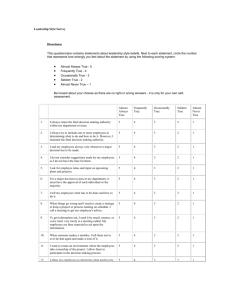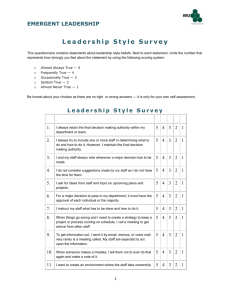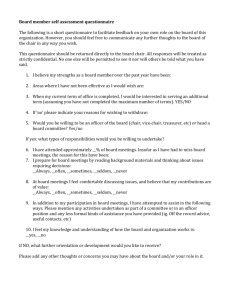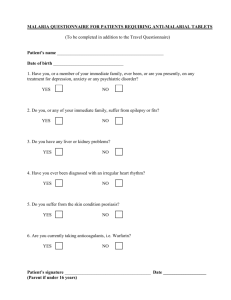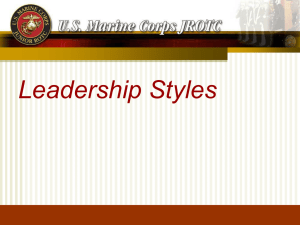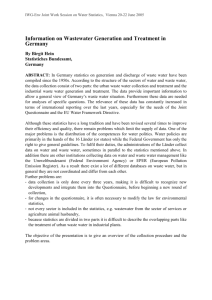Autocratic-Democratic Leadership Style Questionnaire
advertisement
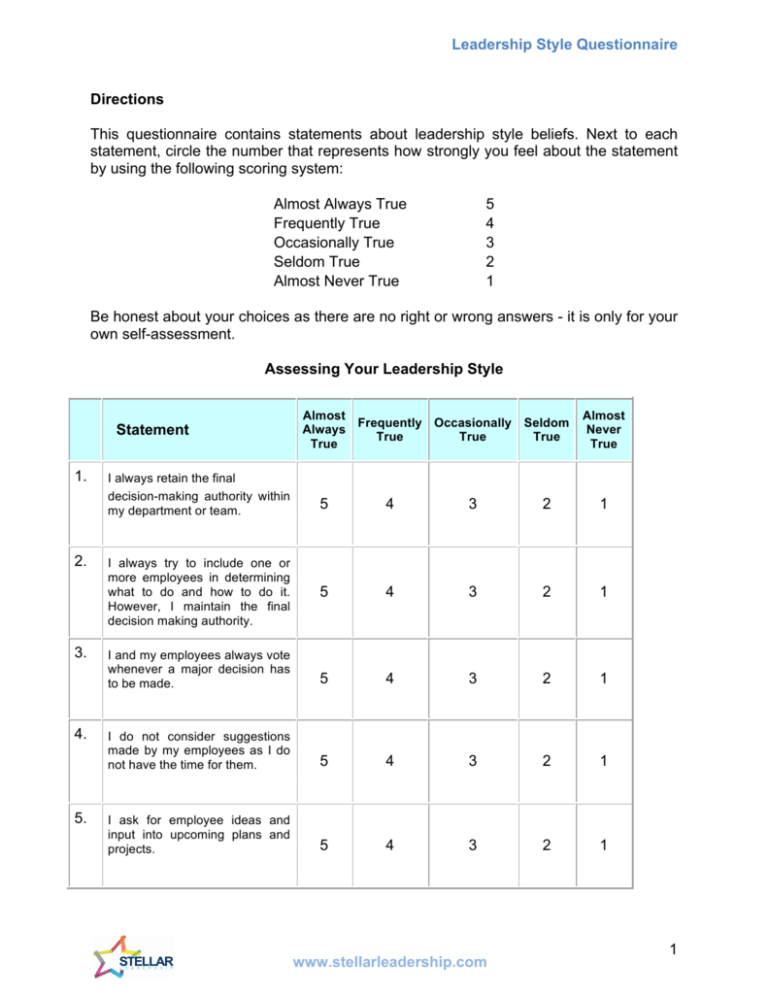
Leadership Style Questionnaire Directions This questionnaire contains statements about leadership style beliefs. Next to each statement, circle the number that represents how strongly you feel about the statement by using the following scoring system: Almost Always True Frequently True Occasionally True Seldom True Almost Never True 5 4 3 2 1 Be honest about your choices as there are no right or wrong answers - it is only for your own self-assessment. Assessing Your Leadership Style Statement 1. 2. 3. 4. 5. I always retain the final decision-making authority within my department or team. Almost Frequently Occasionally Always True True True Seldom True Almost Never True 5 4 3 2 1 5 4 3 2 1 I and my employees always vote whenever a major decision has to be made. 5 4 3 2 1 I do not consider suggestions made by my employees as I do not have the time for them. 5 4 3 2 1 I ask for employee ideas and input into upcoming plans and projects. 5 4 3 2 1 I always try to include one or more employees in determining what to do and how to do it. However, I maintain the final decision making authority. www.stellarleadership.com 1 Leadership Style Questionnaire Statement 6. 7. 8. 9. For a major decision to be approved in my team, it must have the approval of each individual or the majority. Almost Frequently Occasionally Always True True True Seldom True Almost Never True 5 4 3 2 1 5 4 3 2 1 When things go wrong and I need to create a strategy to keep a project or process running on schedule, I call a meeting to get my employee's advice. 5 4 3 2 1 To get information out, I send it by email, memos, or voice mail; very rarely is a meeting called. My employees are then expected to act upon the information. 5 4 3 2 1 5 4 3 2 1 5 4 3 2 1 5 4 3 2 1 5 4 3 2 1 5 4 3 2 1 I tell my employees what has to be done and how to do it. 10. When someone makes a mistake, I tell them not to ever do that again and make a note of it. 11. I want to create an environment where the employees take ownership of the project. I allow them to participate in the decision making process. 12. I allow my employees to determine what needs to be done and how to do it. 13. New employees are not allowed to make any decisions unless it is approved by me first. 14. I ask employees for their vision of where they see their jobs going and then use their vision where appropriate. www.stellarleadership.com 2 Leadership Style Questionnaire Almost Frequently Occasionally Always True True True Statement Seldom True Almost Never True 15. My workers know more about their jobs than me, so I allow them to carry out the decisions to do their job. 5 4 3 2 1 5 4 3 2 1 5 4 3 2 1 5 4 3 2 1 5 4 3 2 1 5 4 3 2 1 5 4 3 2 1 5 4 3 2 1 5 4 3 2 1 16. When something goes wrong, I tell my employees that a procedure is not working correctly and I establish a new one. 17. I allow my employees to set priorities with my guidance. 18. I delegate tasks in order to implement a new procedure or process. 19. I closely monitor my employees to ensure they are performing correctly. 20. When there are differences in role expectations, I work with them to resolve the differences. 21. Each individual is responsible for defining their job. 22. I like the power that my leadership position holds over subordinates. 23. I like to use my leadership power grow. to help subordinates www.stellarleadership.com 3 Leadership Style Questionnaire Almost Frequently Occasionally Always True True True Statement Seldom True Almost Never True 24. I like to share my leadership power with my subordinates. 5 4 3 2 1 5 4 3 2 1 5 4 3 2 1 5 4 3 2 1 5 4 3 2 1 5 4 3 2 1 5 4 3 2 1 25. Employees must be directed or threatened with punishment in order to get them to achieve the organisational objectives. 26. Employees will exercise selfdirection if they are committed to the objectives. 27. Employees have the right to determine their organisational objectives. own 28. Employees seek mainly security. 29. Employees know how to use creativity and ingenuity to solve organisational problems. 30. My employees can lead themselves just as well as I can. www.stellarleadership.com 4 Leadership Style Questionnaire Mark the score of each statement on the questionnaire. For example, if you scored Statement #1 with a 3 (Occasionally), then enter a 3 next to Statement #1. When you have entered all the scores for each question, total each of the three columns. Statement Score Statement Score Statement 1 2 3 4 5 6 7 8 9 10 11 12 13 14 15 16 17 18 19 20 21 22 23 24 25 26 27 28 29 30 TOTAL TOTAL TOTAL Score Authoritaria n Style Participativ e Style Delegative Style (autocratic) (democratic ) (empowerin g) This questionnaire is to help you assess what leadership style you normally operate out of. The lowest score possible for a stage is 10 (Almost never) while the highest score possible for a stage is 50 (Almost always). The highest of the three scores indicates what style of leadership you normally use. If your highest score is 40 or more, it is a strong indicator of your normal style. The lowest of the three scores is an indicator of the style you least use. If your lowest score is 20 or less, it is a strong indicator that you normally do not operate out of this mode. www.stellarleadership.com 5 Leadership Style Questionnaire If two of the scores are close to the same, you might be going through a transition phase, either personally or at work, or you may simply move between styles easily depending on circumstances and mood. If you score high in both the participative and the delegative then you are probably a delegative leader. If there is only a small difference between the three scores, then this indicates that you have no clear perception of the mode you operate out of, or you move easily between modes or you are a new leader and are trying to feel out the correct style for you. Some Thoughts Some of the best leaders operate out of the participative mode and use the other two modes as needed. A leader who has a new team or temporary work-force would probably need to operate out of the authoritarian mode, at least for a while. On the other hand, a leader who has a team of professionals or a team that knows more than she or he does, would probably operate out of the delegative mode. Leaders who want their employees to grow, use a participative style of leadership. As they "grow" into their jobs, then they are gradually empowered by being given more authority (delegative) or freedom to manage their own performance at work. www.stellarleadership.com 6
